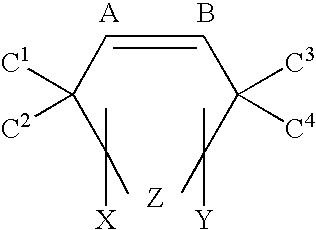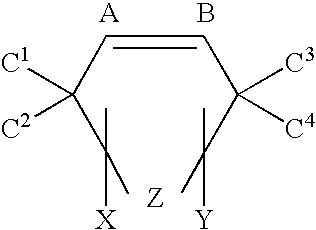Oxygen scavenger block copolymers and compositions
a technology of copolymer and oxygen scavenger, which is applied in the direction of packaging foodstuffs, other chemical processes, non-metal conductors, etc., can solve the problems of oxygen ingress, oxygen ingress, and importance of oxygen permeation through the body, and achieves easy formation and processing, and low tack
- Summary
- Abstract
- Description
- Claims
- Application Information
AI Technical Summary
Benefits of technology
Problems solved by technology
Method used
Image
Examples
example 1
cis-1,2,3,6-Tetrahydrophthalic Anhydride / 1,6-Hexanediol Condensation Prepolymer (PA)
[0116]A 500 ml round bottom flask, (RBF), equipped with a stirrer, thermocouple, nitrogen inlet and a distillation head was charged with 156.6 g of 1,6-hexanediol (HD), 200 g of tetrahydrophthalic anhydride (THPA), 0.1400 g of trimethylolpropane (TMOP) and 0.09 g of titanium butoxide. This is a 1.008 mole ratio of diol to anhydride. The reaction mixture was heated with distillation at 210° C. for one hour, then the temperature was increased to 230° C. and heated for one hour. During this time 24 g of distillate was collected. The distillate was predominantly water, but also contained some 1,6-hexanediol.
[0117]In the second step, 0.09 g of additional titanium butoxide was added and the reaction mixture was heated to 230° C. under vacuum (0.2-0.8 mm) and held for three hours. The resulting polymer was cooled to room temperature.
[0118]GPC analysis showed the polymer had a Mnof 11,364, a Mw of 46,155, an...
example 2
cis-1,2,3,6-Tetrahydrophthalic anhydride / Ethylene Glycol Condensation Prepolymer (PA)
[0119]Using the procedure described above for Example 1, an ethylene glycol / tetrahydrophthalic anhydride polyester resin was prepared starting with a 1.01 mole ratio of diol to anhydride. The resultant polyester resin had a Mn of 8,510 and a Tg of 15° C. The resultant polymer was a glassy, crystalline, solid material.
example 3
Polyethylene Block Copolymer using Polyethylene Monoalcohol
[0120]To 60 g of the Polyester prepared in Example 1 was added 12 g of polyethylene monoalcohol (Aldrich Catalog number 44,447-2, Mn=4600), and 200 ppm of titanium butoxide. The reaction mixture was heated under vacuum at 230° C. for 30 minutes. GPC analysis of the resulting polymer showed a Mn of 5,129, a Mw of 10,665 and a ratio of Mw / Mn of 2.08. The polymer material was a waxy solid. DSC analysis showed that the polymer had a Tg of −39.5° C.
PUM
| Property | Measurement | Unit |
|---|---|---|
| Tm | aaaaa | aaaaa |
| Tg | aaaaa | aaaaa |
| molar ratio | aaaaa | aaaaa |
Abstract
Description
Claims
Application Information
 Login to View More
Login to View More - R&D
- Intellectual Property
- Life Sciences
- Materials
- Tech Scout
- Unparalleled Data Quality
- Higher Quality Content
- 60% Fewer Hallucinations
Browse by: Latest US Patents, China's latest patents, Technical Efficacy Thesaurus, Application Domain, Technology Topic, Popular Technical Reports.
© 2025 PatSnap. All rights reserved.Legal|Privacy policy|Modern Slavery Act Transparency Statement|Sitemap|About US| Contact US: help@patsnap.com



